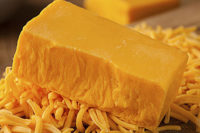
Enzymes and Cultures
by Lori Dahm
While use in cheesemaking continues, other
applications are beginning to expand.
The use of cultures and
enzymes in the dairy industry is by no means new — combinations of
enzymes and cultures are often used in cheese production to foster proper
flavor development and to help reduce aging times. This continues to be an
integral aspect of cheese manufacturing in the United States for desired
efficiency in cheese production.
What is new is the use of enzymes and cultures in an
expanded repertoire of dairy applications, such as fluid milk products to
help eliminate spoilage and extend shelf life; whey fractionation; and
reduced-lactose dairy products. And finally, the use of certain cultures as
prebiotic or probiotic strains is starting to become more widespread.
While the use of enzymes and cultures in cheese
production continues to be a foundation of cheese science in the United
States, the use of these live microorganisms is being expanded into other
applications both within dairy and outside of dairy, where they are proving
to have even wider benefits.
Cheesemaking
In today’s traditional manufacturing processes,
cheese is produced when starter cultures are added to milk in order to
begin fermenting the lactose into lactic acid and begin digesting and
breaking down the milk protein casein. Typical enzymes used as starter
cultures are proteases and peptidases, which drive acidification and also
coagulate the milk, at which time cheese flavor begins naturally
developing.
But the manufacturing pressures that currently face
cheese producers call for the addition of adjunct cultures to yield faster
ripening times. Several cultures are used for this purpose.
“When adjunct cultures are used to accelerate
cheese flavor development and reduce aging times, the strains that are
chosen contain protease, aminopeptidase and in some cases, esterase
enzymes,” says Terri Rexroat, market and product manager of cultures
and enzymes at Cargill Texturing Solutions, Waukesha, Wis. “These
provide the best flavor ‘package’ for most flavorful cheese
varieties.”
Accelerated cheese ripening requires that cheese
flavor development be sped along by the addition of adjunct cultures so
that the desired flavor is realized faster than it would be without their
addition.
“When these protease and aminopeptidase enzymes
are released by the bacterial cells, they allow for faster development of
the types of flavors desired in that cheese, and they also help prevent the
development of undesirable off-flavors such as bitterness,” Rexroat
says. “These enzymes break down bitter peptides into flavor
compounds, which in turn helps to reduce bitterness and accelerate cheese
flavor development.”
Shortening the cheese aging period by accelerating
flavor development and thereby accelerating the ripening of the cheese also
helps manufacturers reduce cheese storage costs. But certain varieties of
cheese are better candidates for this process than others.
“The cheese varieties that are the best
candidates for accelerated flavor development are those that are aged for
extended periods, like over six months,” Rexroat says. “These
include cheddar and related varieties such as parmesan-type and Swiss
cheese. Mild-flavored cheeses or unaged cheeses such as mozzarella are not
good candidates.”
Much work has been spearheaded in the world of cheddar
cheese flavor by Dr. Mary Anne Drake, associate professor of food science
at the Department of Food Science at the Southeast Dairy Foods Research
Center, North Carolina State University, Raleigh, N.C.
The flavor profiles of cheddar cheese can vary widely,
and in 2001 Drake developed a comprehensive “cheddar cheese
lexicon” that identifies and describes each of the flavor compounds
of cheddar cheese. This lexicon has been a useful tool to quantify and
document the different flavor effects upon cheddar cheese that result from
factors such as region, manufacturer, levels of fat, micoflora and age.
Cheddar cheese that has been aged a significant amount
of time develops a nutty flavor that consumers find most pleasing in this
variety of cheese, and the latest project with Drake’s lexicon
studied whether the use of adjunct cultures could help younger cheddar
cheeses develop this desirable nutty flavor.
Drake worked with Don McMahon and Jeff Broadbent of
the Western Dairy Center at Utah State University, Logan, Utah, on the
Nutty Flavor Development project. When a particular strain of Lactococcus
lactis was used as an adjunct culture in cheddar cheese manufacturing,
the resulting cheese did have an increased nutty flavor, even after less
ripening time, and beefy/brothy notes, were fostered by higher ripening
temperatures.
How enzymes and cultures can affect flavor development
goes hand in hand with reducing aging times, since the addition of the
adjunct cultures affects the overall ripening process and resulting flavor.
Cheese manufacturers today choose a package that will work throughout the
life cycle of the cheese development to appropriately develop the desired
flavor balance.
“The enzymes used to develop cheese flavor are
basically the same as those used to accelerate cheese flavor development
— aminopeptidases and proteases,” Rexroat says. “In
cheese varieties that benefit from fruity flavor compounds such as
parmesan, bacteria with strong esterase enzyme activity will be beneficial.
In some cases, combining strains with different types of enzyme activity
can provide a synergistic benefit to cheese flavor.”
These adjunct cultures are added to the fluid milk at
the initial stages of cheese production at the same time that the
acid-producing cultures are added. They are activated after the
acid-producing cultures begin fermenting the milk, and technical experts
recommend that several trials runs be conducted to determine the exact
package of enzymes and cultures necessary for desired flavor and targeted
ripening effects.
Keeping It Fresh
One of the areas of excitement in the dairy world with
regard to the use of enzymes and cultures is their use in fluid milk
products to prevent spoilage, sometimes in place of additives and
preservatives.
“Fluid milk and other fresh products such as
yogurt and sour cream can benefit from the use of cultures that produce
substances called bacteriocins, which are metabolites that are naturally
produced by the cells,” Rexroat says. “They inhibit the growth
of certain specific types of bacteria, which is desirable if those bacteria
are pathogens or spoilage organisms.”
This is particularly of interest in the world of
organic dairy products.
“We are expanding our line of DURAFresh,
all-natural fresh-keeping products to include products that will be
certified organic. The basis for the DURAFresh technology is controlled
fermentation using proprietary cultures and a patented process,” says
Doug Allen, commercial director of dairy at Kerry Bio-Science, Hoffman
Estates, Ill. “The process results in naturally produced acids and
metabolites that are effective in controlling spoilage
organisms.”
DURAFresh is a spray-dried powder that is added to a
variety of products.
The use of cultures can possibly extend shelf life in
optimal conditions, and the use of these cultures and the resulting
metabolites have the potential to replace chemical preservatives. But
again, choosing cultures carefully is important for a successful end
application.
“The types of spoilage bacteria or pathogenic
bacteria that are killed by such cultures vary by type of bacteria. Some
species in the lactic acid bacteria family such as Lactococcus, Leuconostoc
and Pediococcus are especially useful producers of
bacteriocins,” Rexroat says. “The bacteriocin-containing
culture can either be added as a live culture or as attenuated
(inactivated) cells that are useful because of the bacteriocins that they
produced when they were alive.”
These developments are rapidly becoming more important
and topical in today’s market where consumers want fresh, natural and
organic dairy products.
“The demand for organic products and the
ingredients that go into them will continue to increase,” Allen says.
“There will be greater scrutiny over the ingredients used in organic
products, and having an all-natural and organic ingredient to help products
maintain freshness is of significant value.”
How Sweet It Is
One of the enzymes most frequently used in dairy
applications is lactase, because its sensory effect is one of sweetness
that is useful in certain products such as yogurt, and also because it
breaks down the milk sugars into digestible components for the
lactose-intolerant consumers.
“The use of lactase is growing, primarily because
of its use to make reduced lactose products such as fluid milk, or even
yogurt,” Rexroat says. “The sales of lactose-reduced fluid milk
are growing due to increased availability of products, in tandem with
increased awareness of these products.”
Awareness of lactose intolerance is increasing for
several reasons. For one, it is now understood that as humans age, the
body’s ability to digest the milk sugar lactose disappears of natural
accord.
In addition, lactose intolerance is common to several
ethnicities, and as these segments of the population in the United States
grow larger and become more substantial in purchasing power, products that
are formulated to help with lactose intolerance are being rapidly
introduced to market.
“Lactose-reduced milks continue to grow in
volume versus declines in other milk categories. The whole area of lactose
reductions in dairy products fits in well with the ‘health and
wellness’ trend as it opens up the consumption of dairy products to a
large segment of the population,” Allen says. “We can see
processors building designer milk beverages combining lactose reduction
with our ‘healthy’ ingredients.”
Whey Relevance
And finally, the big area of the future for dairy
ingredients — whey — is also a factor in the use of enzymes.
Treating whey with enzymes has been standard in the dairy industry for
several years.
“Enzymes can be used to hydrolyze whey so that
it has different functional properties and different nutritional
properties,” says K.J. Burrington, director of dairy applications at
the Wisconsin Center for Dairy Research, Madison, Wis. “When whey
protein is hydrolyzed, some of the smaller peptides are split from the
protein molecule, which changes the way the protein binds water and also
provides better heat stability.”
In addition to changing the functional properties of
whey, treating whey with enzymes also changes the nutritional attributes of
the ingredient.
“Treating whey with enzymes breaks the protein
into different components, which changes the digestibility of the protein
with the idea that it is more readily absorbed in the body,”
Burrington says. “Hydrolyzed whey proteins are used in weightlifting
supplements because of this association. But hydrolyzed whey proteins can
become bitter, and although some companies have their own propriety
technology to reduce that bitterness by cleaving the protein molecule at
specific points, most still have bitterness.”
For that reason, usually the level of hydrolysis for
commercial whey protein ingredients is relatively low, such as 5 percent or
10 percent, unless the product is being used for medical situations such as
tube feeding of surgical patients in the hospital.
Although treating the whey sugar lactose with enzymes
is less common, this process also has a purpose.
“The technology to treat whey to convert the
lactose into glucose and galactose has been around for some time,”
Allen says. “The resulting whey syrup can be used as a partial
replacement for sweeteners in products like ice cream and yogurt, and if
sweetener costs begin to increase, this technology may become more
important and more practical from a cost-benefit standpoint.”
The enzymes used to hydrolyze whey into different
components are typically protease and pepidases. While whey protein
ingredients are starting to become valued, the lactose has yet to find its
mirrored market niche. However, new enzyme technology is being used to
convert the lactose into higher priced prebiotics, which might be the
opportunity for lactose to find market value as an ingredient.
All told, enzymes and cultures use continue to be
important in the dairy industry, and their use is being expanded and
further developed on multiple fronts: for whey conversion, for shelf life
optimization and for accelerated cheese ripening and flavor development.
$OMN_arttitle="Enzymes and Cultures";?>
